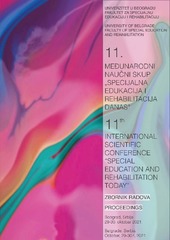Приказ основних података о документу
Morfosintaksičke sposobnosti kod starijih ljudi: preliminarno ispitivanje
Morphosyntactic abilities in the elderly: a preliminary research
| dc.creator | Vuković, Mile | |
| dc.creator | Jerkić, Lana | |
| dc.date.accessioned | 2021-11-12T11:16:55Z | |
| dc.date.available | 2021-11-12T11:16:55Z | |
| dc.date.issued | 2021 | |
| dc.identifier.isbn | 978-86-6203-150-1 | |
| dc.identifier.uri | http://rfasper.fasper.bg.ac.rs/handle/123456789/3795 | |
| dc.description.abstract | Uvod: Istraživanje jezičkih sposobnosti kod starih osoba značajno je za razu- mevanje normalnih i patoloških obrazaca jezičkog ponašanja. Prema empirij- skim podacima, stare osobe bez neurološkog oštećenja ispoljavaju teškoće u pronalaženju sadržajnih reči i razumevanju jezika. Takođe se navode određene promene u oblasti sintaksičke strukture. Cilj: Cilj ovog istraživanja bio je da se procene morfosintaksičke sposobnosti kod starih osoba bez neurološkog oštećenja. Metod: U istraživanju je učestvovalo ukupno 40 ispitanika. Eksperimentalnu grupu činilo je 20 starih osoba koje su bile podeljene u dve podgrupe. Prvu po- dgrupu činilo je 10 ispitanika iz kategorije rane starosti (65-75 godina), a dru- gu 10 ispitanika koji su prema godinama života pripadali kategorijama srednje i kasne starosti (preko 76 godina). Kontrolnu grupu sačinjavalo je 20 ispitanika srednjeg životnog doba (46-58 godina). Za prikupljanje podataka korišćen je Test morfosintaksičkih sposobnosti. Rezultati: Primenom statističkih postupaka utvrđeno je da stariji ispitanici imaju značajno lošije morfosintaksičke sposobnosti u odnosu na kontrolnu grupu ispitanika (t=-4,271; df=38; p<0,001). Takođe je utvrđeno da ispitanici iz podgrupe rane starosti imaju značajno bolje morfosintaksičke sposobnosti u odnosu na ispitanike iz kategorije srednje i kasne starosti (t=2,965; df=18; p<0,01). Ispitivanjem povezanosti između godina starosti ispitanika i rezultata na testu pokazano je da sa starenjem dolazi do slabljenja morfosintaksičkih sposobnosti (r=-0,748; p<0,01). Zaključak: Analizom dobijenih podataka pokazano je da morfosintaksičke sposobnosti opadaju s povećanjem godina života. Najbolje morfosintaksičke sposobnosti imali su ispitanici srednjeg životnog doba (kontrolna grupa), za- tim ispitanici iz kategorije rane starosti, dok su najlošije sposobnosti pokazale osobe iz kategorije srednje i kasne starosti. | sr |
| dc.description.abstract | Introduction: Research on language abilities among the elderly is essential for understanding normal and pathological patterns of language behaviour. According to empirical data, the elderly without neurological impairment exhibit content-word-finding difficulties and auditory language comprehension deficits. Certain changes in the area of the syntactic structure have also been showed. Aim: The aim of this study was to investigate morphosyntactic abilities among the elderly without neurological impairment. Method: A total of 40 respondents participated in the study. The experimental group consisted of 20 elderly persons who were divided into two subgroups. The first subgroup consisted of 10 respondents from the category of young-old (65-75 years of age), and the second of 10 respondents who, according to age, belonged to the categories middle-old and oldest-old (over 76 years of age). The control group consisted of 20 middle-aged respondents (46-58 years of age). The Morphosyntactic Abilities Test was used for data collection. Results: Using statistical procedures, it was found that elderly respondents had significantly worse morphosyntactic abilities than the control group of subjects (t=-4.271; df=38; p<.001). It was also found that respondents from the subgroup of young-old had significantly better morphosyntactic abilities than respondents from the category of middle- old and oldest-old (t=2.965; df=18; p<.01). Examination of the relationship between the age of the subjects and the test results showed that morphosyntactic abilities weaken with age (r=-.748; p<.01). Conclusion: The analysis of the obtained data showed that morphosyntactic abilities decrease with age. Middle-aged respondents (control group) had the best morphosyntactic abilities, followed by the young-old category, while the category of middle-old and oldest-old demonstrated the poorest abilities. | sr |
| dc.language.iso | sr | sr |
| dc.publisher | Univerzitet u Beogradu – Fakultet za specijalnu edukaciju i rehabilitaciju / University of Belgrade – Faculty of Special Education and Rehabilitation Publishing Center of the Faculty | sr |
| dc.rights | openAccess | sr |
| dc.rights.uri | https://creativecommons.org/licenses/by-sa/4.0/ | |
| dc.source | Zbornik radova - 11. Međunarodni naučni skup „Specijalna edukacija i rehabilitacija danas“, Beograd, Srbija, 29–30.10.2021. | sr |
| dc.subject | jezik | sr |
| dc.subject | morfosintaksičke sposobnosti | sr |
| dc.subject | starije životno doba | sr |
| dc.subject | starost | sr |
| dc.subject | language | sr |
| dc.subject | morphosyntactic abilities | sr |
| dc.subject | the elderly | sr |
| dc.subject | old age | sr |
| dc.title | Morfosintaksičke sposobnosti kod starijih ljudi: preliminarno ispitivanje | sr |
| dc.title | Morphosyntactic abilities in the elderly: a preliminary research | sr |
| dc.type | conferenceObject | sr |
| dc.rights.license | BY-SA | sr |
| dc.citation.epage | 320 | |
| dc.citation.spage | 313 | |
| dc.identifier.fulltext | http://rfasper.fasper.bg.ac.rs/bitstream/id/4360/bitstream_4360.pdf | |
| dc.identifier.rcub | https://hdl.handle.net/21.15107/rcub_rfasper_3795 | |
| dc.type.version | publishedVersion | sr |


